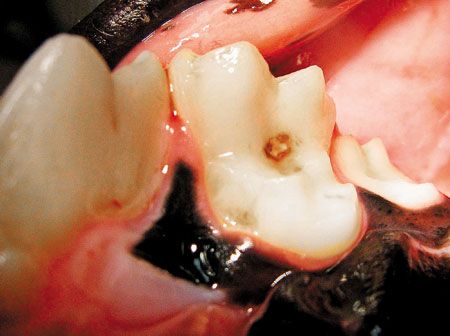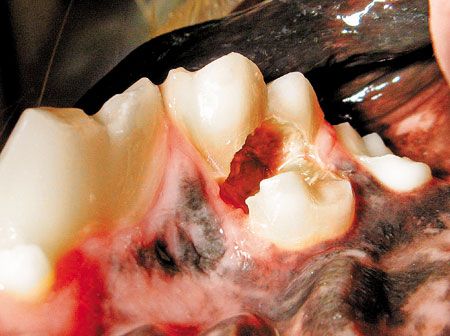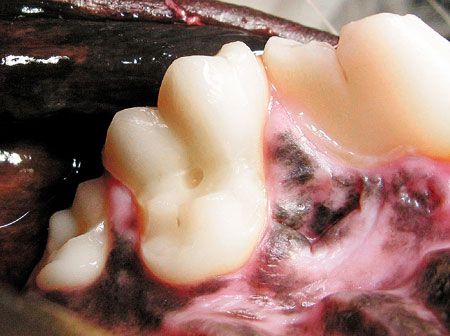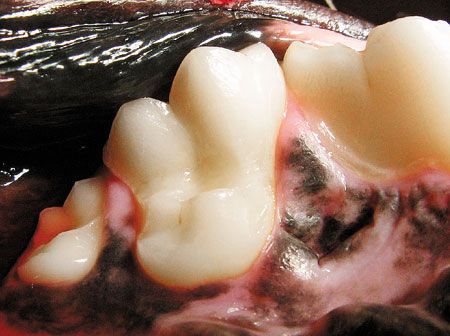Detection, treatment of dental caries in dogs
Canines' canines are often unaffected, but be on the lookout for this condition in other dentition.
Next >

Photo 1:
An early carious lesion in the left maxillary first molar (209) in a dog. Note the brown discoloration of the enamel. Exploration of this region revealed soft, gritty and diseased enamel.
Human dentists commonly discover caries, or cavities, on the teeth of their patients. Caries are produced when bacteria use simple carbohydrates on the tooth surface, resulting in the production of acids that break down the dental enamel.
The Centers for Disease Control and Prevention consider fluoridation of public water supplies, which started in 1945, one of the greatest achievements in public health in the 20th century.1 While fluoridation resulted in a dramatic decrease in the disease, cavities still remain one of the most common of human maladies.
Fortunately, caries occur much less frequently in dogs than in people. One study revealed an incidence of just 5.2 percent in dogs.2 Most dogs in the study had lesions that were bilaterally symmetrical, supporting the idea that variations in tooth anatomy act as predisposing factors.
Indeed, most of a dog's dentition does not favor the formation of caries. The conical shape of most of their teeth doesn't lend them to food deposition and retention as do the relatively horizontal crowns in people. Exceptions to this are a dog's molars-the distal aspect of the mandibular first molar and the rest of the maxillary and mandibular molars resembles that of human premolars and molars, making them more susceptible to food accumulation.
An additional factor at play in the lower incidence of caries in dogs is the comparatively greater alkaline pH of the saliva (7.5 vs. 6.5), which acts as somewhat of a buffer to the acids themselves. The interdental space is much wider in a good portion of the canine arcade, thus minimizing food retention.

Photo 2:
Extensive debris is present in this left maxillary first molar (209) in a dog.
Detection is key
Despite the decreased incidence of caries in dogs, this condition is possible in any canine patient, necessitating careful observation during oral evaluation and cleaning under anesthesia. Early detection of pits and fissures in young dogs provides an opportunity to alter the crown anatomy before lesions develop. Careful observation of the enamel of all teeth, especially the cusps of the molars and the developmental groove of the maxillary fourth premolars, is indicated.
A dental explorer can facilitate detection of pits and fissures. Use the explorer’s sharp point to probe the enamel’s surface to help recognize distinct alterations in the enamel surface that could result in caries.
The explorer can also help you detect early carious lesions by providing a feel for soft or gritty defects. Often these defects are brown or black (Photo 1). Larger defects characteristically have food and debris packed within them (Photo 2).
Removal of the debris reveals the diseased tooth structure-indeed, the true extent of the damage is visually assessed only by debris removal (Photo 3). Using a dental bur to carefully remove all diseased dentin and enamel allows for complete visual examination and allows the practitioner to determine if sufficient crown structure is still present to contemplate restoration.

Photo 3:
Removal of debris from the defect in Photo 2 shows the deep extent of the defect.
How to treat
Treatment decisions should rely first and foremost on the radiographic appearance of the affected tooth. Pulp exposure does not have to be present for tooth vitality to be compromised. A periapical lucency or increased pulp-cavity diameter (when compared with other teeth) indicates nonvitality. Extraction or root canal and restoration is indicated in these patients.

Photo 4:A final cavity preparation is ready for restoration in the right maxillary first molar (109) in a dog. Pits are common in this location and likely predisposed this tooth to decay.
A radiographically viable tooth that has near pulp exposure also should receive strong consideration for root canal therapy and restoration or extraction if sufficient crown is preserved. Restoration in this case is a less desirable option, and, if chosen, radiographic evaluation at three and six months and periodically thereafter is indicated.
Lesions of lesser severity may be débrided and restored with composite and then monitored radiographically in six months and then at yearly intervals (Photos 4 and 5).

Photo 5:The tooth in Photo 4 after restoration with a composite. Radiographic follow-up is indicated in six months and at yearly intervals thereafter.
Conclusion
Although caries occur less commonly in dogs than in people, they're detectable and treatable in many cases. Restorations for caries are technique-sensitive and require experience in successful application. Veterinarians interested in addressing these lesions should pursue courses in dental restoratives at various continuing education venues, including the Veterinary Dental Forum at veterinarydentalforum.com and programs listed on the American Veterinary Dental College website at
www.avdc.org
.
References
1.
Centers for Disease Control and Prevention. 2008 water fluoridation statistics. Available at: www.cdc.gov/fluoridation/statistics/2008stats.htm. The 2010 statistics are available at www.cdc.gov/fluoridation/statistics/2010stats.htm.
2.
Hale FA. Dental caries in the dog.
J Vet Dent
1998;15(2):79-83.